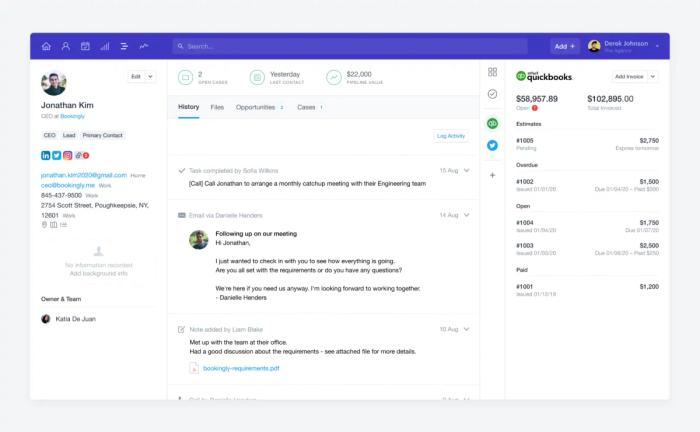One aspect that is usually underestimated in the world of sales is the power of relationships. But professional relationships build trust through communication which often increases customer loyalty and sales revenue.
The Sandler sales methodology is a technique that transforms the traditional sales model to turn hesitant reps into confident professionals and skeptical customers into loyal clients.
While this may sound ideal, it’s important to understand how it works and why. Read on to discover how this strategy could revolutionize your sales strategy.
What is the Sandler sales methodology?
The Sandler sales methodology is a consultative selling approach that focuses on building mutual trust between a sales rep and future clients. This technique emphasizes honest communication, qualification processes, and no-pressure environments.
It is designed to guide sales professionals and recipients through the entire selling process in a pleasant and valuable way. From initial contact all the way to closing the deal.
Sandler sales methodology elements
This popular sales method consists of seven simple yet effective elements that we’ll take a look at below. These steps will help you to gain more control over your sales game.
1. Develop bonds and rapport
Your first step is to develop a genuine connection with your potential client. A comfortable atmosphere encourages open dialogue and sets the stage for a long-term partnership.

The rapport you build often dictates how easily you will be able to navigate later stages of the sales process. This is not just a formality, but a strategic move that helps in building trust with prospective buyers.
How to do this?
Instead of launching directly into your sales pitch, you might chat about a recent industry event or even the client's weekend plans.
2. Determine up-front contract details
Right from the outset, it's a good idea to lay down some ground rules. Think of these as mutual commitments that clarify what each party expects from the other.
Clear agreements help avoid misunderstandings later. They also serve as reference points that make it easier to hold both parties accountable as you progress.
How to do this?
Let's say a sales manager wants to sell a software solution. To ensure mutual commitment and set clear expectations right from the start, they could propose the following up-front contract details:
The client agrees to provide one hour of their time for a comprehensive software demo that will cover the full range of features, benefits, and customization options. In return, the sales professional involved commits to tailor a demo to the client's specific needs and address any questions or concerns they may have.
3. Understand the prospect’s pain points
Next, you'll need to dig deep to uncover a client's specific challenges. Adapting your solutions to tackle these issues increases the likelihood of making a meaningful sale.
The more precisely you can pinpoint and articulate the client's pain points, the more compelling your solution will appear. The goal is to demonstrate empathy and understanding, not just blatantly selling a product.
How to do this?
Engage the prospect in conversation and ask questions, perhaps even through a survey. For example, you might offer cybersecurity solutions and have arranged a call with the recipient.
Ask open-ended questions and let the interviewee tell the story. If they tell you that they struggle with frequent data breaches, this is likely to be one of their major pain points.
4. Find out what budget the prospect has
Money can be a sensitive topic to discuss, but they're unavoidable especially in the sales world! If you're aware of the client's budget constraints from the get-go, you can adjust your offerings accordingly.
Knowing their budget also helps you manage your own resources better and ensure you don't overcommit. It's a balancing act between meeting the client's needs and staying within financial boundaries.
How to do this?
Before diving into your pitch, tactfully ask your prospective client about their budget. This open conversation about financial constraints allows you to tailor your proposal to specific needs and avoid pushy sales tactics.
For instance, if the client has a limited budget, you might suggest a basic package instead of a premium one.
5. Identify the decision
This step gives you a thorough understanding of how the client makes buying decisions. This means asking:
- Who is involved in decision making?
- When are decisions made?
- What criteria are essential?
- Why do certain factors influence choices?
- How does the process unfold?
Gaining these insights allows sales professionals to align a product demonstration with the prospect's buying process.
How to do this?
Suppose you're offering a CRM system to a new company that is in the market for one. To identify the decision-making process, you can inquire about who will make the final decision and if it will be made by the whole team or business leaders.
By gathering such information, you will be able to tailor your proposal accordingly.
6. Demonstrate your compliance with the agreement
It's time to deliver on what you've promised. In this phase, sales professionals showcase how their offerings align with client expectations and the mutually agreed-upon terms.
This step is crucial in building trust as it reinforces the belief that you are honest and that the product is the right fit for their requirements.
How to do this?
To do this effectively, you can employ interactive product demonstrations. Showing an ideal solution in action and highlighting its ability to fulfill needs and preferences will solidify the prospect's confidence in their purchase decision.
7. Ensure post-sale procedures
Closing the deal is just the beginning – at this point, sales professionals need to shift their focus to post-sale procedures. This involves setting the stage for the product or service’s implementation and ensuring a smooth transition.
They also emphasize the importance of future communications to maintain the relationship. You can do this by identifying potential solutions to emerging needs, and continue building a long-term partnership that will be mutually beneficial.
How to do this?
A week after implementation, say, you should reach out to see how the client is doing with your product or service. Regular check-ins not only help you nip any issues in the bud, but also keep the door open for future collaborations.
Sandler vs. traditional sales: key differences
Great communication might seem like the basis of any sales process. But how does it differ from the traditional form of sales?
Approach to sales
The Sandler sales tactic adopts a consultative approach, focusing on building relationships and understanding customer pain points. This is in stark contrast to the aggressive salesperson stereotype that many traditional sales methods embody.
While the pushy salesperson aims for a quick and successful sale, the Sandler's sales approach creates a relationship based on understanding and conversation.
The process
With Sandler's, the qualification process is rigorous. This is different from other sales processes that often rush through the qualification stage in order to move quickly to the closing stage.
Here, however, there is an emphasis on open-ended and third level questions that are asked with a genuine view to truly understanding prospective customers.
Continuous learning and sales training
Sandler is committed to training and equipping sales teams with the skills they need for every phase of the sales process. From building rapport, through the fulfillment stage, all the way to post-sale care.

Some other methodologies also offer training programs, but not usually with the same level of depth or focus on continuous improvement. The Sandler model guarantees that the sales team is always learning, adapting, and improving.
No-pressure environment
Sandler's philosophy of sales closing is unique. Instead of applying pressure to make a quick sale, the focus is on creating a comfortable environment in which nobody is in a hurry.
This is achieved through up-front contracts and clear communication to allow for a more transparent decision process. In contrast, some other methodologies employ more direct selling techniques that can feel pushy to potential customers.
Custom solutions for B2B
The Sandler sales methodology is particularly effective for complex B2B sales where understanding the customer's business is crucial. That’s because this approach advocates for custom solutions tailored to the client's specific needs, unlike those methodologies that offer a one-size-fits-all product.
This consultative approach is more aligned with today's business landscape, where both individualized services and customer success are highly valued.
Best practices for the Sandler sales methodology
The above applies to conceptual selling using the Sandler sales strategy. But that's not all, as we also have some best practices that will come in handy when using this method.
Craft clear contracts
Up-front contracts are your roadmap for the entire sales process, eliminating the guesswork and setting expectations right from the start. However, they must be understandable and completely transparent, with no hooks.
If the contracts are well drafted, both you and your client will know what to expect and the whole experience will be transparent.
- Tip: In the meeting where you discuss up-front contracts, ask the client several times if they understand the scope of services, deliverables, and expected outcomes.
Master the art of building rapport
Building rapport doesn’t just mean making small talk, it’s about connecting on a deeper level and understanding what makes your client tick. That’s what’s essential here, because you're not just selling a product, you’re building a long-term relationship.
- Tip: Find common ground by asking about their recent business wins or challenges.
Identify more pain points
Do you already know where the problem lies? Great, but there may be more.
Identifying your client's pain points is like finding the X on a treasure map - it shows you exactly where to dig. As soon as you discover what's bothering the client, you can tailor your pitch to solve these specific issues.
- Tip: Ask the client directly, "Can you walk me through the challenges you're currently facing?"
Ask open questions often
Open-ended questions are your best friend during the discovery phase. They give you more than just “yes” or “no” answers, providing insights into your client's world that help you understand their needs and how you can meet them.
- Tip: Instead of asking if they're looking for a new solution, ask "What's motivating you to explore new options?"
Emphasize discovery over persuasion
With the Sandler method, discovery trumps persuasion every time. The goal isn't to get the prospect to buy, but rather to make them so aware of what they need. That way the product sells itself.
This type of communication makes the client feel understood and valued.
- Tip: Ask questions such that the potential customer experiences enlightenment.
Be transparent about the costs
Talking about money can be awkward, but being transparent eases the tension. This ensures you're both on the same page and eliminates any surprises down the line.
It's a way to show respect for their budget while also being clear about the value you offer.
- Tip: There’s no point in stalling; being honest about the costs will pay off ultimately.
Create a 'sweet spot' early on
Finding the conversation 'sweet spot' means you want to connect without anything disturbing you during the qualification phase. If you engage the right people in the right way, you will gain loyal consumers faster than you might think.
- Tip: Immediately after you start a video call and say “hello”, ask if the prospect is comfortable or if they can see and hear you well, for example.
Be proactive during implementation
Custom solutions show that you've done your homework. They prove you've listened and tailored your offering in order to meet the prospect’s specific needs. But implementing such tools can be tough, so don't leave your client alone afterwards.
- Tip: If you have included information about implementation in your interactive product demos, you can send relevant videos to the client or offer to personally help implement customized solutions.
Encourage customers to talk about their fears
Let's face it, no one likes feeling like they’re being pushed into a sale. Customers may be afraid that you only want to seal the deal, so assure them what your role is and that they can be totally honest with you.
The Sandler selling system puts a premium on the quality of relationships, so if a prospect still has some concerns then encourage a discussion to help solve them.
- Tip: If the clients seem hesitant, ask them to share their concerns so that you can clear up any doubts.
Establish a post-sale relationship as a priority
The sale might be closed, but the connection isn't. Communication after a sale is your best chance to acquire loyal customers. Ensure that they're happy, feel supported, and are aware of how to make the most of your product or service.
- Tip: Set up regular follow-up emails or calls to discuss how implementation is going and if they have any questions or need further support.
Get help from Capsule and grow your relationships
Managing relationships with a large number of customers can be difficult if you don’t have the right system.

Capsule is a smart and straightforward online customer relationship management (CRM) system designed to help you build stronger bonds with clients, increase sales, and save time.
Capsule provides essential features to streamline your workflow, including:
- Contact Management to nurture relationships
- Sales Pipeline to give better control
- Sales Analytics for informed decision making
- Workflow Automation to reduce busy work
Also, our tool integrates seamlessly with various other software like Microsoft Outlook, Mailchimp, QuickBooks Online, Xero, and more to provide a unified view of your customer interactions.
You can try it for free for 14 days.
Final thoughts
The Sandler sales methodology presents a refreshing approach to sales that focuses on building trust, understanding client pain points, and maintaining a no-pressure environment.
Unlike traditional sales methods, Sandler emphasizes a consultative strategy for developing relationships and finding custom solutions.
If you are looking to streamline your customer relationship management, Capsule CRM would be a smart choice. Try Capsule free for 14 days and see for yourself how it can improve your business.
Frequently Asked Questions
The Sandler sales method, developed by David Sandler, focuses on understanding a prospect's pain points, building trust, and guiding the decision making process in a way that benefits both parties. It usually involves a sales rep acting as an advisor, asking questions until both parties feel comfortable with the product or service.
Sandler's sales process includes seven steps, but many companies pick a few at the beginning and add more as they grow. Building rapport, establishing ground rules, uncovering pain points, qualifying prospects, and closing the sale are all part of the Sandler sales process.
In both methodologies, sales reps interact directly and closely with potential clients. Both methodologies prioritize identifying the prospect's needs, challenges, and business context. However, while Sandler does this through questioning, Challenger does it by teaching and tailoring insights.
The Sandler selling methodology emphasizes understanding the prospect, and the Challenger sales method encourages sales reps to challenge customer assumptions and offer new perspectives.
The methodology can be used and followed without charge. It may, however, be beneficial to participate in Sandler sales training for large teams and organizations. Depending on the specific program and level of qualification, Sandler sales training typically costs $1,000 to $3,000, although the official unified price is not disclosed on their website.
The Sandler sales agenda sets up a respectful and clear conversation. It makes sure both sides know what will be discussed and what they want to achieve. Sales reps can focus on the prospect’s problems and talk about solutions that help business growth. Doing so allows both parties to agree on the topics and goals for the meeting and helps reduce any misunderstandings.
The Sandler selling system offers unique advantages that many other sales methodologies only touch on at a surface level. It improves sales success by helping reps focus on the prospect’s specific needs, leading to more personalized interactions, stronger relationships, and higher close rates.
The Sandler rule of three plus encourages sales reps to ask at least three clarifying questions to understand a prospect’s concerns fully.
For example, instead of assuming the first answer reveals the whole issue, reps ask follow-up questions like, “Can you explain more about that challenge?” or “What impact does that have on your team?”
The Sandler buyer-seller dance is a strategic give-and-take where the sales rep uncovers the prospect's needs. The rep and prospect agree on each step, making sure both are committed to moving forward.
For example, the rep might ask questions to understand the prospect’s budget and timeline before presenting a solution. If the prospect has concerns, they can address them together, preventing any surprises later. Both parties feel comfortable and in control.




